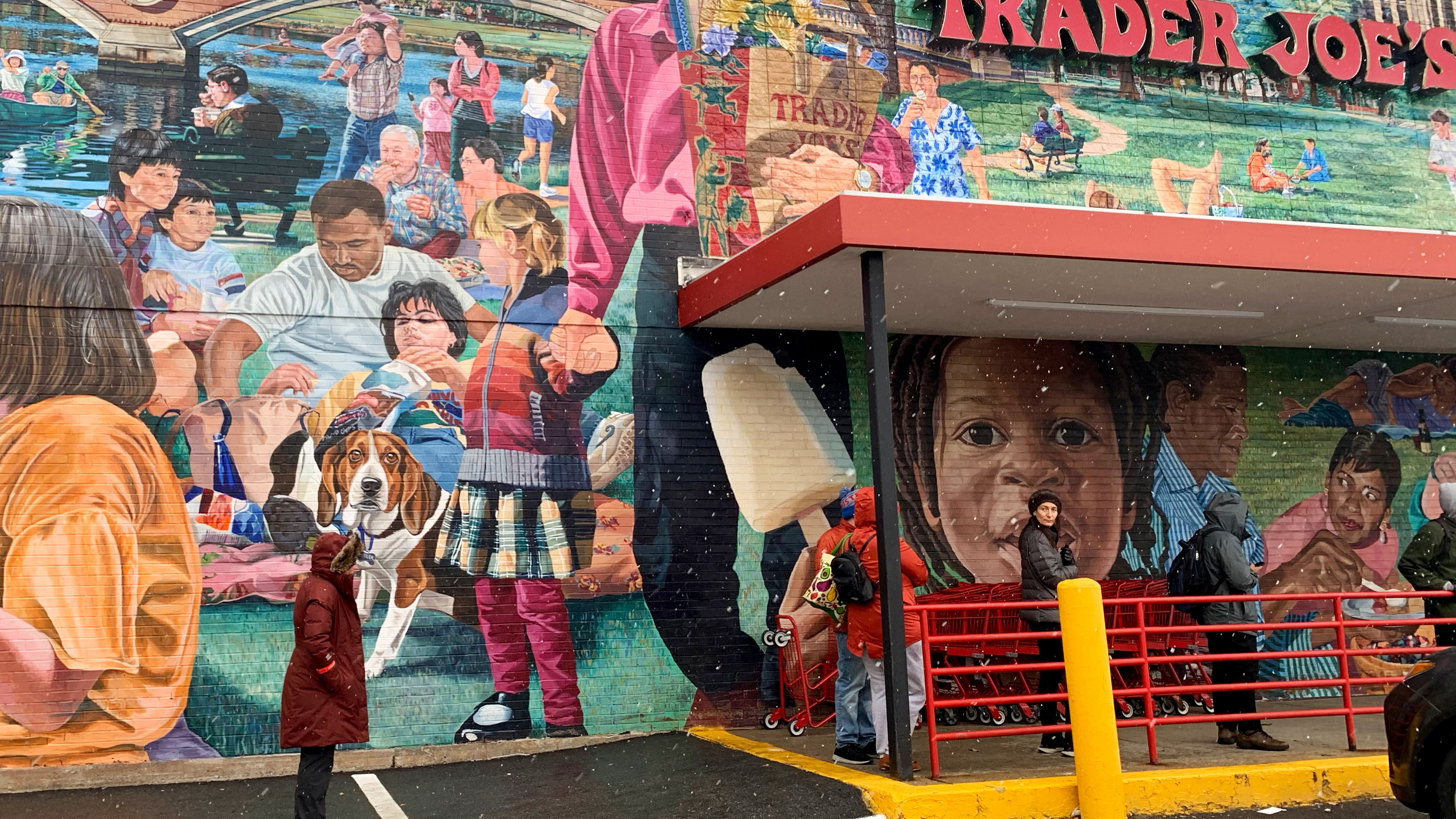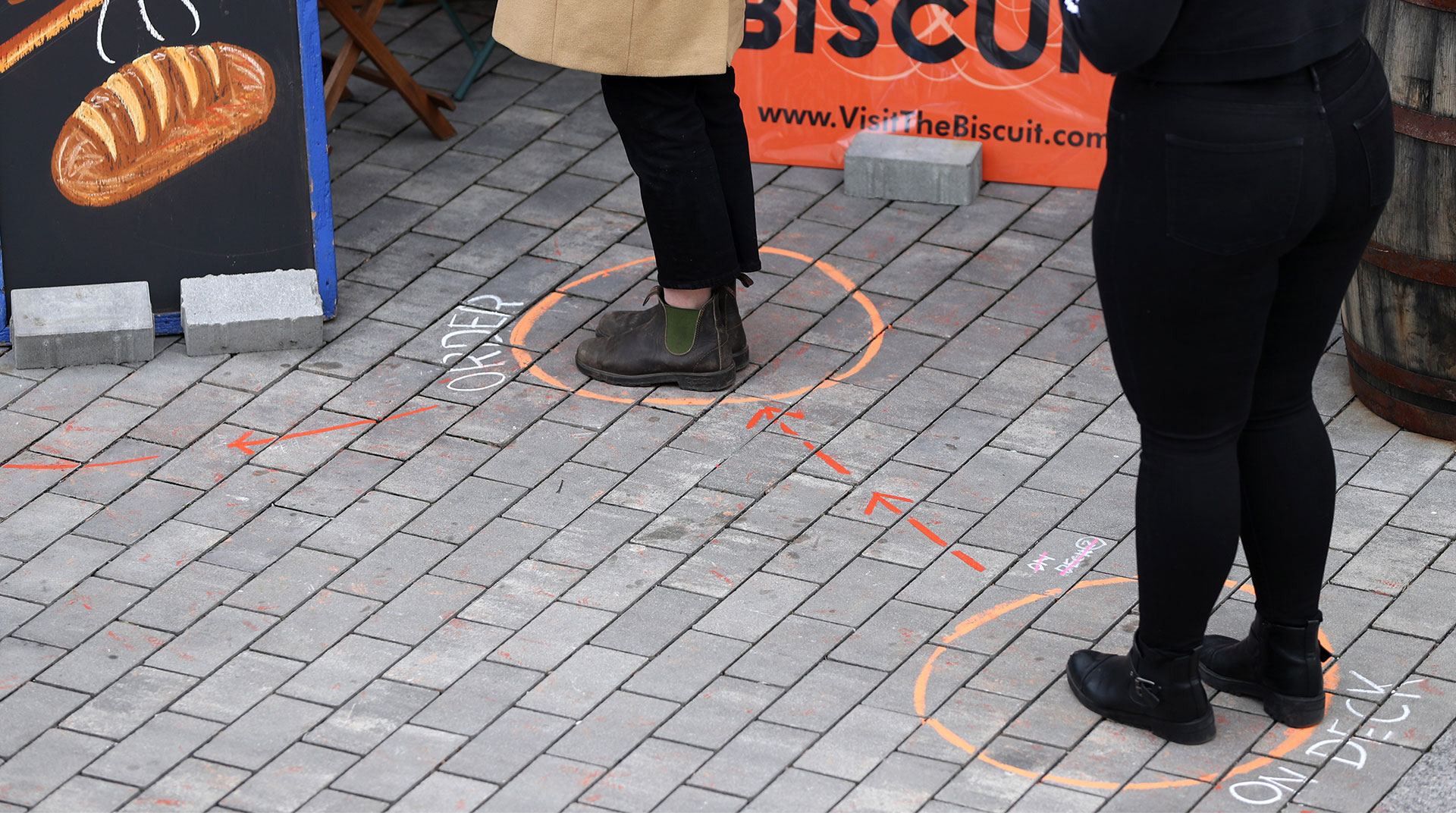“No one had a pandemic plan in place, but they are quickly developing them in terms of deep-cleaning methods and controlling crowds at essential-services retailers, which are actually thriving,” said Jeff Pandolfo, a leasing director for The Shopping Center Group’s New York and Virginia divisions.

Shoppers wait in line outside of Trader Joe's, in Cambridge, Massachusetts. The store limits the number of shoppers allowed inside at once and offers sanitizing wipes upon entry
As the COVID-19 pandemic spreads, that could mean allowing limited numbers of shoppers into the likes of Costco or Trader Joe’s, as well as making sure that people stay at least six feet apart as they wait in line outside.
Retailers, brokers, property managers and landlords are working together to follow federal social-distancing guidelines and other safety measures, or in some cases to shutter properties and stores according to local or state lockdown orders.
NewMark Merrill Cos., which owns and/or manages retail properties in California, Colorado and Illinois, has tasked its on-premises staff with deep-cleaning properties as never before, and the company is using Wi-Fi-connected cameras to monitor its centers with a view toward safety, said Sanford D. Sigal, NewMark Merrill’s president and CEO. “We’re looking at traffic at our centers and are using our technology to understand where people are still shopping and how they’re using our common areas.”
Based in California, NewMark Merrill recognized the need to tighten its communications with tenants as officials began to impose strict shelter-in-place orders, Sigal said, noting that his communications philosophy is, the more the better. “As the lockdowns grew, we reached out to neighbors and tenants, and we’re making sure that we’re paying attention to the market as it develops.”
“Owners and retailers are grappling with what is undeniably one of the greatest communications challenges in retail history, and they are doing it without a playbook”
The unprecedented scale, depth and complexity of the crisis makes communication critical for stakeholders in retail real estate, said Mark Winter, president and founding partner of Identity PR, which represents retailers, owners, restaurants, hotels and architects. “Owners and retailers are grappling with what is undeniably one of the greatest communications challenges in retail history, and they are doing it without a playbook,” Winter said. “We have never seen anything that compares.”
Fortunately, the industry now has access to online teleconferencing software, social-media channels and other tools for keeping lines of communication open. “Some are doing an amazing job of leveraging those tools and technologies to convey clear and timely messages,” Winter said, “while others are straight-up failing, as they scramble to put those technologies and tools in place.”

Shoppers stand at a distance at the Safe Supply outdoor grocery store at Bow Market on March 21 in Somerville, Massachusetts. In order to comply with the city of Somerville's food-safety protocol and social-distancing recommendations, patrons registered to shop in advance and stood six feet apart at all times. Vendors handled and bagged all food
The Shopping Center Group, for one, had set up remote-collaboration tools prior to the crisis, said Alan Freeman, the firm’s operating partner for the Carolinas, and is now using that infrastructure to communicate frequently with its internal teams and external clients. “My list of clients was the first thing that I lay down on my dining room table, which is now my office,” he said. “I try to contact those clients as often as I can and listen to them. Our role is adviser, and so we also share with them what others are doing. They’re taking that information back to their board meetings, which are now conference calls, and coming up with plans.”
Communication is so important because, faced with a blank slate of silence, a company’s partners and clients can experience a higher degree of uncertainty or a sense of disconnection that erodes morale, said Gregory Tannor, an executive managing director and a principal in the New York City office of Lee & Associates. With more than 20,000 confirmed COVID-19 cases in Manhattan at press time, New York is the national epicenter of the pandemic. People in the region are hurting, Tannor said, and the need for human connection and reassurance is acute. In such a context, staying in contact with one another can be beneficial, even if the subject is not strictly business. “It could be sharing photos of pets,” he said, “or the hikes that people go on, or just asking them how their families are.”
“We are focused on getting our communication so good that, when we come back, we are even closer than when we left”
Indeed, these kinds of communications may be more viable right now than making hard-and-fast declarations about the highly uncertain future. “The biggest challenge that all organizations have faced is the fluid nature of the crisis and the dissemination of reliable and actionable information at the federal and state levels,” Winter said. “It is extremely difficult to build a communications strategy when information is changing minute by minute and day by day.”
Blanket communications could be a mistake too for landlords, given the uneven effects of the crisis on different retailers in their portfolios, said Jason Baker, co-founder of Houston brokerage firm Baker Katz and executive director of the X Team Retail Advisors network. Some retailers are operating as normal, he notes, while others are completely closed, and still others are maintaining modified hours or truncated services — such as restaurants that have moved to takeout-only policies. “It’s important to understand the specific retailer, the nature of their business, operating history [and] creditworthiness, and to deliver a unique message with that tenant’s specific situation in mind,” Baker said. He, too, emphasizes the importance of maintaining a collaborative mindset. “At this point, tenants aren’t quite sure, in many cases, what questions to even ask,” Baker said. “Remain a partner through this process and work with them while they figure out a way forward.”
Having rapidly put up communications tools, NewMark Merrill is perfecting its approach, says Sigal. “We are now all linked remotely, and we have had some great calls over videoconferencing,” he said. “We are focused on getting our communication so good that, when we come back, we are even closer than when we left.”
According to Winter, though, smaller retailers and landlords face a tougher challenge on the communication front: Many have always used physical spaces as their primary medium. “It is hard to believe, but some do not have a website, and many others do not have active social-media channels,” Winter said. “The retailers and centers that are getting it right are thinking differently, leveraging technologies and tools, stepping up instead of stepping back and investing deeply in their virtual connection with audiences.”
By Joel Groover
Contributor, Commerce + Communities Today


